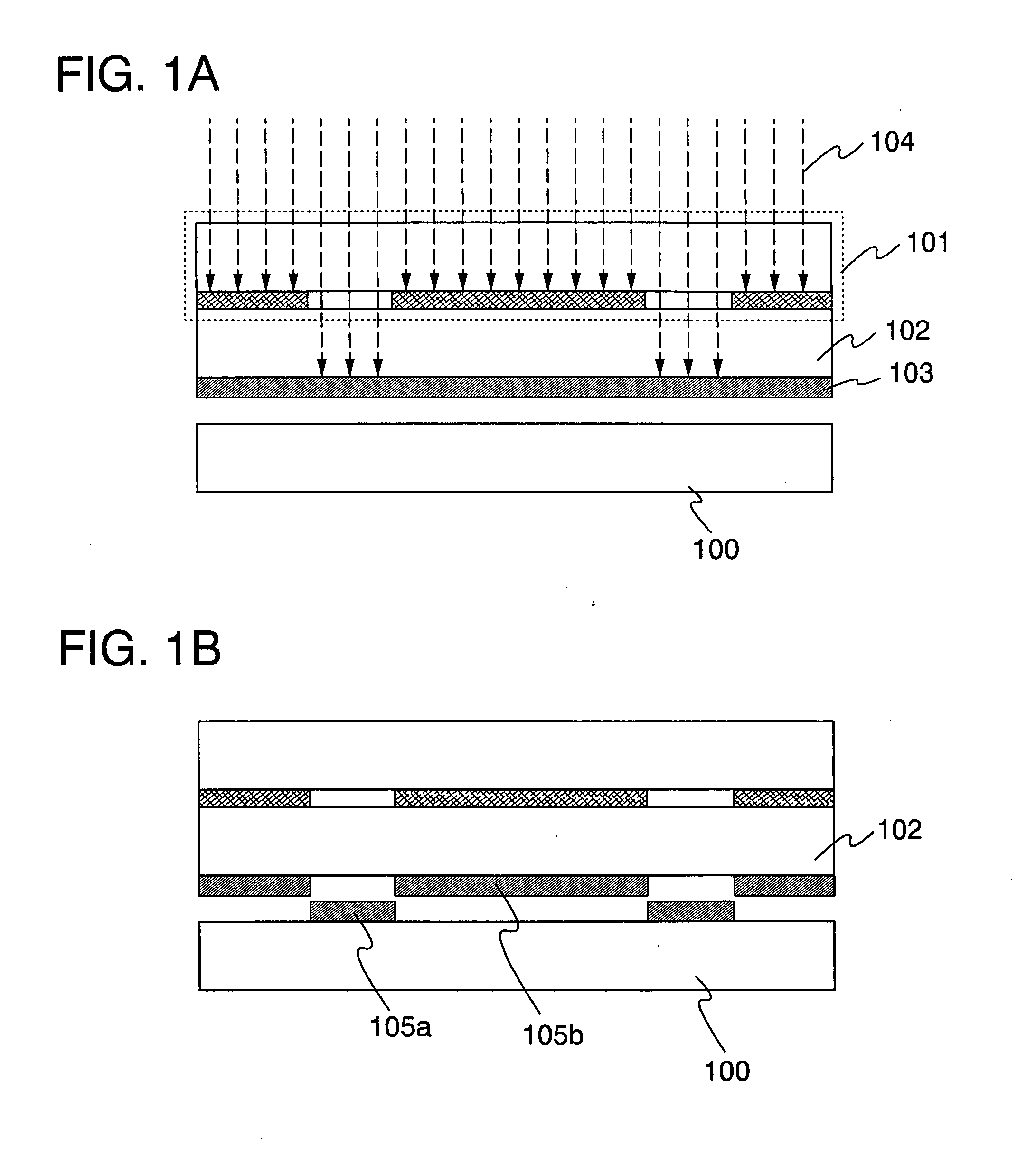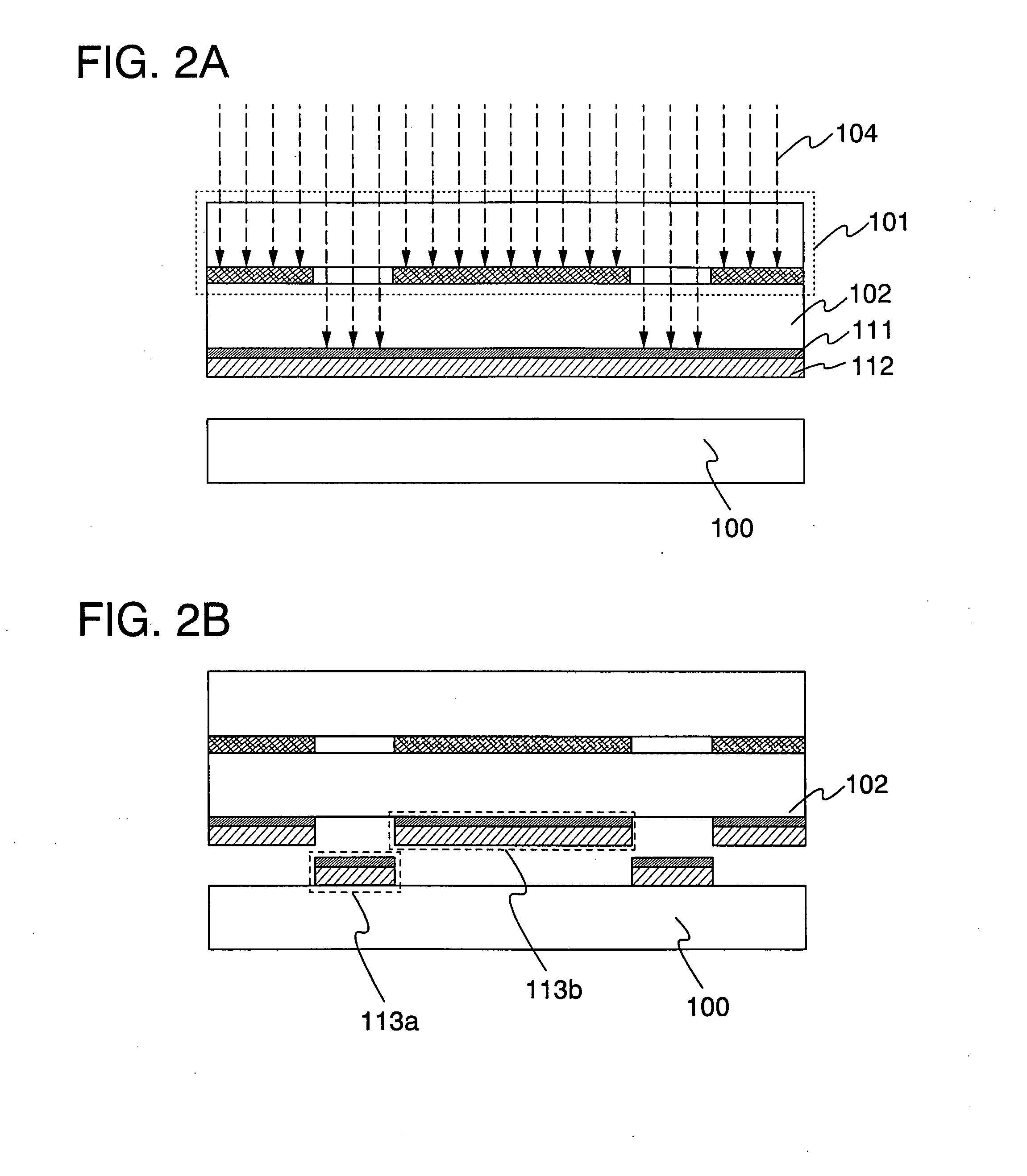Method of manufacturing semiconductor device
a manufacturing method and semiconductor technology, applied in the direction of semiconductor devices, basic electric elements, electrical appliances, etc., can solve the problems of semiconductor film contamination, reduced throughput, waste of most of the resist material, etc., and achieve high mass productivity, high integration
- Summary
- Abstract
- Description
- Claims
- Application Information
AI Technical Summary
Benefits of technology
Problems solved by technology
Method used
Image
Examples
embodiment mode 1
[0054]In this embodiment mode, steps of selectively forming a layer having a given shape over a substrate without using a photolithography process will be described below. FIGS. 1A to 4C are cross-sectional views illustrating steps of selectively forming a layer over a substrate.
[0055]As shown in FIG. 1A, a light absorbing layer 103 is formed over one face of a light-transmitting substrate. Further, a mask 101 is provided on the other face side of the light-transmitting substrate 102. A substrate 100 is provided so as to oppose the light absorbing layer 103. Note that the one face and the other face of the light-transmitting substrate 102 oppose each other.
[0056]A substrate which transmits light of a laser beam to be applied later can be used as the light-transmitting substrate 102. Accordingly, a substrate which does not absorb the wavelength of the laser beam to be formed later may be used as appropriate. As typical examples of the light-transmitting substrate 102, there are a qua...
embodiment mode 2
[0129]In this embodiment mode, a method of manufacturing a semiconductor element using Embodiment Mode 1 will be described with reference to FIGS. 12A to 12F.
[0130]Here, as the semiconductor element, an inverted staggered thin film transistor 188 will be described. Note that a semiconductor element such as a staggered thin film transistor, a coplanar thin film transistor, a diode, a MOS transistor, or the like can be manufactured without limitation to an inverted staggered thin film transistor.
[0131]As shown in FIG. 12A, a light absorbing layer 181 is formed over one face of a light-transmitting substrate 102. Here, as the light absorbing layer 181, a tungsten layer is formed to a thickness of 10 nm to 1000 nm or more over the light-transmitting substrate 102 by sputtering. Further, a substrate 100 is provided so as to oppose the light absorbing layer 181. A mask 101 is provided on the other face side of the light-transmitting substrate. Note that the one face and the other face of ...
embodiment mode 3
[0146]In this embodiment mode, a method for forming a contact hole through a more simplified process with high reliability at low cost will be described with reference to FIGS. 13A to 14D.
[0147]When conductive layers are electrically connected to each other with an insulating layer interposed therebetween, an opening (so-called contact hole) is formed in the insulating layer. In this case, a mask layer is not formed over the insulating layer, and the opening is selectively formed by laser beam irradiation. A first conductive layer is formed, an insulating layer is stacked over the first conductive layer, and a region where the opening is formed in the stacked first conductive layer and insulating layer is selectively irradiated with a laser beam from the insulating layer side. When the first conductive layer is formed of a conductive material which absorbs a laser beam, the laser beam is transmitted through the insulating layer and absorbed by the first conductive layer. The first c...
PUM
 Login to View More
Login to View More Abstract
Description
Claims
Application Information
 Login to View More
Login to View More - R&D
- Intellectual Property
- Life Sciences
- Materials
- Tech Scout
- Unparalleled Data Quality
- Higher Quality Content
- 60% Fewer Hallucinations
Browse by: Latest US Patents, China's latest patents, Technical Efficacy Thesaurus, Application Domain, Technology Topic, Popular Technical Reports.
© 2025 PatSnap. All rights reserved.Legal|Privacy policy|Modern Slavery Act Transparency Statement|Sitemap|About US| Contact US: help@patsnap.com



